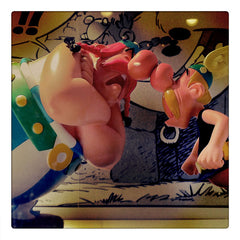Asterix creator Albert Uderzo

The Roman Empire has been no match for this village of Gauls, and neither are our hearts.
When asked about the enduring success of The Adventures of Asterix comic strip he created with René Goscinny in 1959, Albert Uderzo replied, “We are like magicians who don’t know how they do a trick.” Uderzo may not understand it, but with 325 million copies of Asterix books sold worldwide, the secret to the trick is clear: Asterix is hilarious.
Uderzo is a self-taught artist, who first became interested in comics through reading the Mickey Mouse strip in Le Pétit Parisien. He was only 14 when his first illustration was published, a parody of Aesop’s fables that appeared in Junior magazine. As a young man he worked for several magazines, drawing comic heroes such as Flamberge and Chopinard and illustrating the news as a reporter-illustrator.
In 1951, Uderzo met René Goscinny when they worked together on a feature on etiquette for the women’s weekly Bonnes Soirées. The two men hit it off immediately, and began a life-long collaboration. They created Jehan Pistolet, Luc Junior and Oumpah-Pah. But their most famous creation, Asterix, would develop as a result of bad timing.
Goscinny and Uderzo created Pilote magazine in 1959, and they wanted to include a strip about a typically French hero. They originally chose the trickster fox from the fables of Renart, however artist Jean Trubert was already in the works with a project on that subject. So they scrambled to find a suitable replacement.
Their second choice was to set a story during the time of the Gauls with a character they called Asterix. The Adventures of Asterix the Gaul appeared on page 20 of the first issue of Pilote and was an immediate hit – more than 300,000 copies of that first issue were sold. With the popularity of Asterix increasing, Uderzo decided in 1968 to devote himself entirely to the strip.
Uderzo continued on alone after Goscinny’s death in 1977, but in 2012 he announced his retirement from the drawing board. Asterix and all of our favorite characters continue to be published around the world, with artist Didier Conrad carrying the torch.
This year, the 40th anniversary of the Angoulême International Comics Festival included a major retrospective of Uderzo’s work which shone a richly-deserved spotlight on Asterix and all of Uderzo’s characters. His work is notable for his mastery of movement, his characterization of animals, and his beautiful scenery. Uderzo is colorblind so he handed off the coloring of his work, but in the early years he did all the drawing and inking himself. In fact, to keep to the high-speed schedule they had, he sometimes skipped the sketches and drew directly in ink!
If you haven’t read Asterix in a while (or especially if you’ve never read it!), spread out on the couch with a book or two. You’ll be glad you did.